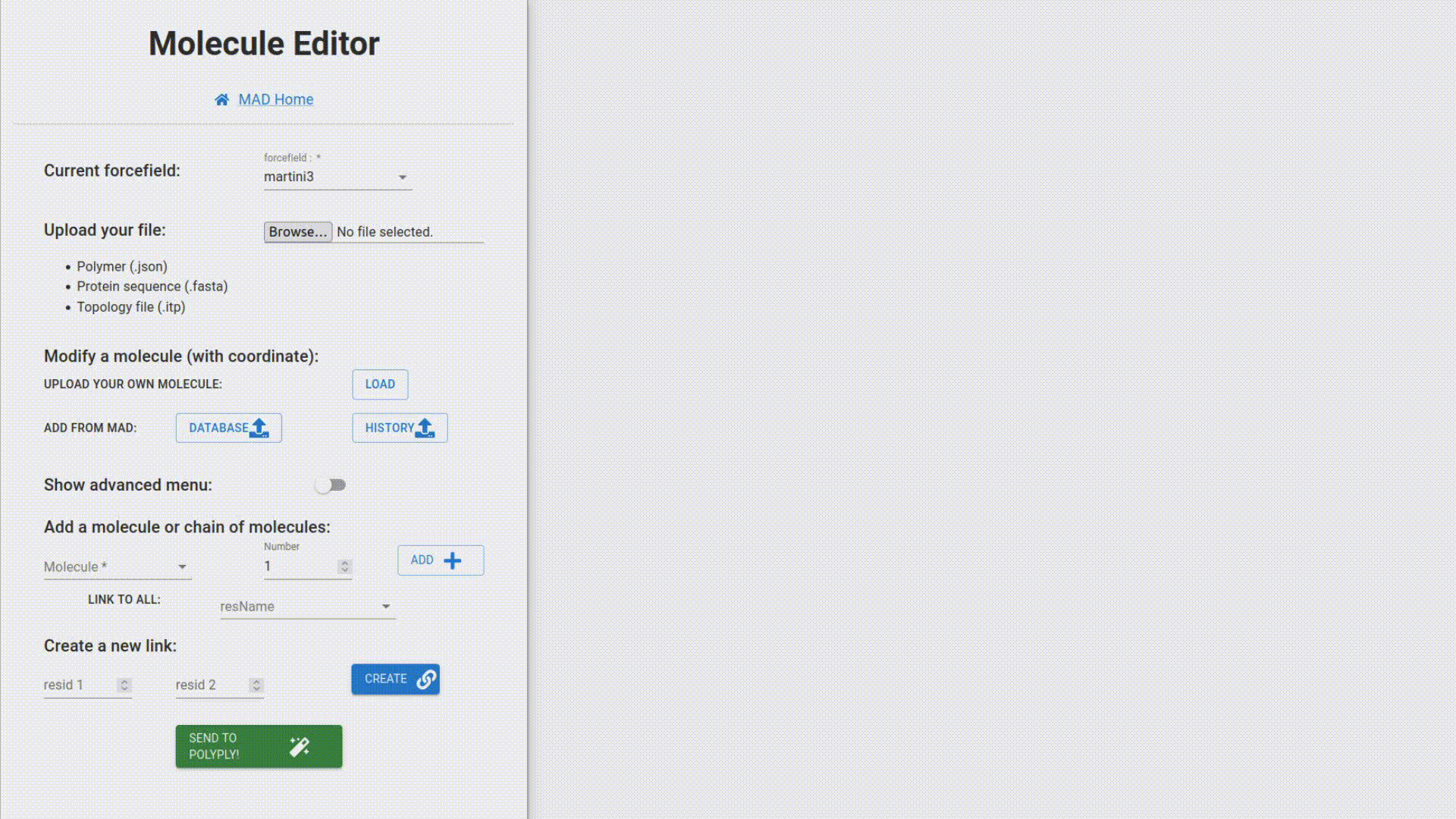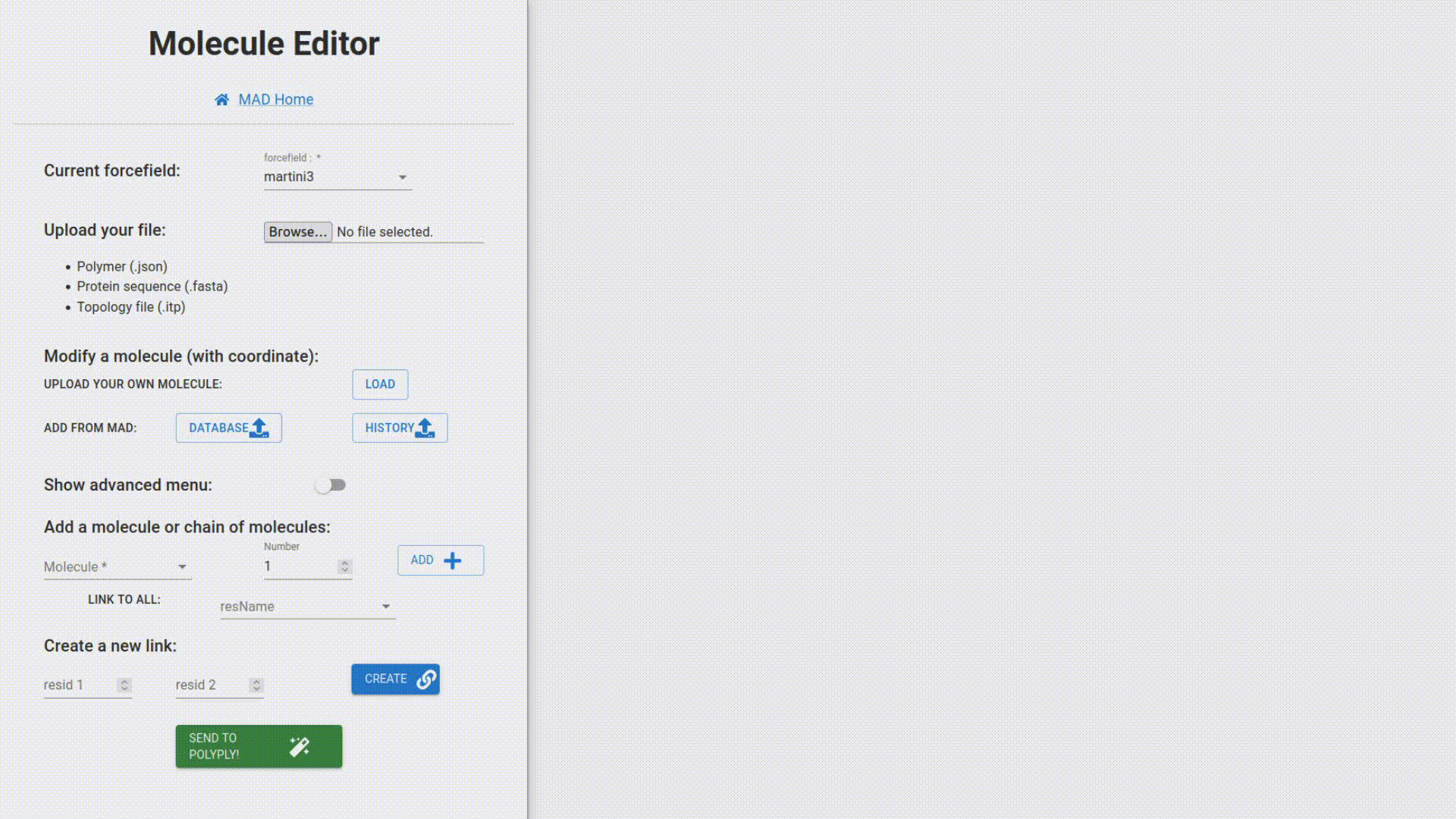- Add a tripeptide: Select the forcefield martini3 and then choose the right amino acid (here we choose Glutamic acid) and select its the number of copy, in the present case we choose 3 repetitions. Than click on the right-end button to add a chain of 3 Glutamic acids to the graphical view.
- Add another peptide and link it to the previous Select arginine as a type and 2 as a number of copy. Then add to the graphical view.
- Link them: You may drag the two chains in close proximity to link them. Alternatively you may click right on the graphical view and use the "magic link" option.
-
Process you polymer blueprint and generate CG files:
By clicking on the
NEXT button in the bottom central console, you will be prompted for various processing options: change the size of the box for coordinate generation, modify the number of molecules to position in this box and lastly choose a name for your molecule. - Done: You can download your molecule and save it in your history.
Polymer Editor
We are excited to deliver this new feature as an easy way to generate new polymer (such
as peptides or polysaccharides) or to modify existing molecules (such protein post-translational
modifications like for PEGylation or glycosylation).
The MAD:Polylmer Builder allows any registred user
to design coarsegrained polymer in a user-friendly way,
with no need for any command line or computing skills.
The MAD:Polymer Builder is powered by the
Polyply[1] program to generate the
necessary files and coordinates for molecular dynamic simulations.
Users can generate a molecule using some of the molecular compounds provided by Polyply
by using the Martini3 forcefield or the Martini 2 forcefield, or by processsing
your molecule definitions (from the MAD database, MAD history, or upload file directly).
The following examples will guide you through the multiple uses of MAD: Polymer Editor.
1. How does MAD: Polymer Editor work?
2. Create a simple peptide
3. Create an isopeptide link
4. Load a molecule
5. Pegylate a protein
6. Limitations
person_add
Because the service makes use of our computational resources, it is required for you to sign
in order to have access to the MAD:Polymer Editor
General organization
The MAD: Polymer Editor interface is divided
into two sections:
An interactive graphical viewer and a detailed left-end menu.
The graphical viewer features mouse drag and click interactions to select,
remove or assemble elements of the polymer.
The left-end menu supports various operations to create and modify both
the molecular components and their bonds.
Once, your polymer is sketched, MAD: Polymer Editor
will process it. If there are any issues with the process, you may be prompted for
eventual additional informtions. Once the coordinates are generated, a small minimization
is run with gromacs to ensure the reliability
of the molecule, which is then displayed in the MAD: Polymer Editor
interface. Where, the generated files can be downloaded and added to your
history for future use inside MAD ecosystem.
Create a simple peptide
In this section, we are going to generate a small peptide of 5 amino acids composed of 3 GLU and 2 ASP for the martini3
forcefield.
info_outline
Be sure that you have linked residue with a continuous id number ( do not do : (1-2-3)-(7-8)-(4-5-6) do
(1-2-3)-(4-5-6)-(7-8) instead). It may generate an error with polyply if the continuity is not respected.
How to load a molecule
The MAD:Polymer Editor can start working on preexisting molecular coordinates
Create an isopeptidique link
In this part, we want to create a link not handled by polyply. We want to do an isopeptide link
between a peptide that contains only Lysine for instance and a peptide that contains Valine and
Glutamic acid. In this case, we don't have to change the beads type.
- Create 2 peptides: As we have seen before, create 2 peptide chains. The first one will contain only Valine and the second one contains different amino acids
- Link and send: Now you can link it and send it to the server to computation.
- Fix link: A problem with be raised by polyply. The link between amino acid is not provided by the polyply database. So you should fix this link, you can define which bead you want to connect, change beads type, and other link parameters.

Pegylate a protein
In this part, we want to apply a post-translation modification: attaching polyethylene glycol (PEG or PEO)
molecules to a protein. This modification is called Pegylation and it helps improve the properties
of a protein :
- Stability: Polyethylene glycol is a stable molecule that does not break down easily, so attaching it to a protein can help to stabilize the protein and extend its shelf life.
- Solubility: This molecule is hydrophilic (water-loving), so attaching it to a protein can help to increase the protein's solubility in water. This can be especially useful for proteins that tend to aggregate or clump together, as the PEG can help to keep them in solution.
- Lifetime: Polyethylene glycol can shield a protein from being recognized and broken down by the body's immune system, which can help to extend the protein's half-life in the body. This can be especially useful for proteins that are normally broken down quickly, as it allows them to remain active for a longer period.
- Targeting: It can be attached to proteins in such a way that it can act as a "stealth" molecule, helping the protein to evade the body's immune system and targeting specific cells or tissues for delivery.
- Load your protein: Load the file about your protein: we need the coordinates of the protein (format .gro) and the topology (format .itp). Section "Modify a protein" and upload your files.
- Add polyethylene glycol: Then add your polyethylene glycol (called PEO on the polyply molecule list residue). You can choose to link them directly on a certain type of residue (Alanine for instance), then you will add a chain of PEO of the desired length to every Alanine. You can also do it by hand: generate a chain and plug it into your protein "manually".
- Send for computation : Send to the server to do your modification. You will have a mistake because polyply doesn't know how to link a PEO and an amino acid. So click on the fixed link and select the beads that you want to connect (You can apply to every residue of the same type). You can download the files used for the demo :

Current limitations
There are still some limitations to this new MAD feature :
- Impossible to generate structure:, For now, generate big structure is not available. Because computational resources are limited and not allowed to generate a big system. For example, it's impossible to create a sphere of a cylinder.
- Number of molecule limited: Polyply has a limited number of molecule available. More molecules will be available in future updates. You can find all the molecules containing in polyply database for martini3 here.
- Links are limited: For the moment all links between molecules are provided by polyply...
- Chirality, blend of polymer
References
- Grünewald, F., Alessandri, R., Kroon, P.C. et al. Polyply; a python suite for facilitating simulations of macromolecules and nanomaterials. Nat Commun 13, 68 (2022). https://doi.org/10.1038/s41467-021-27627-4